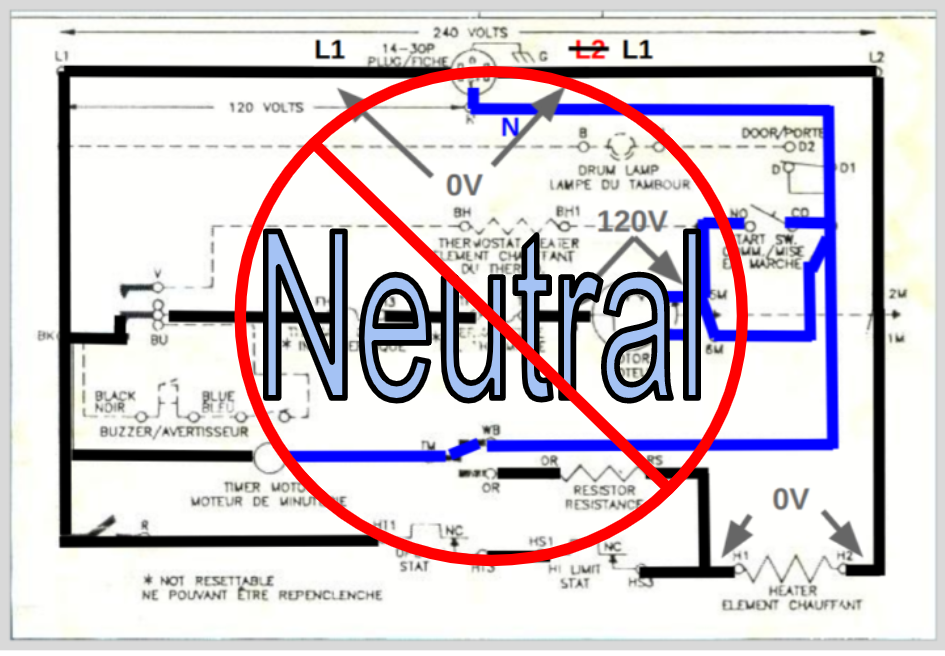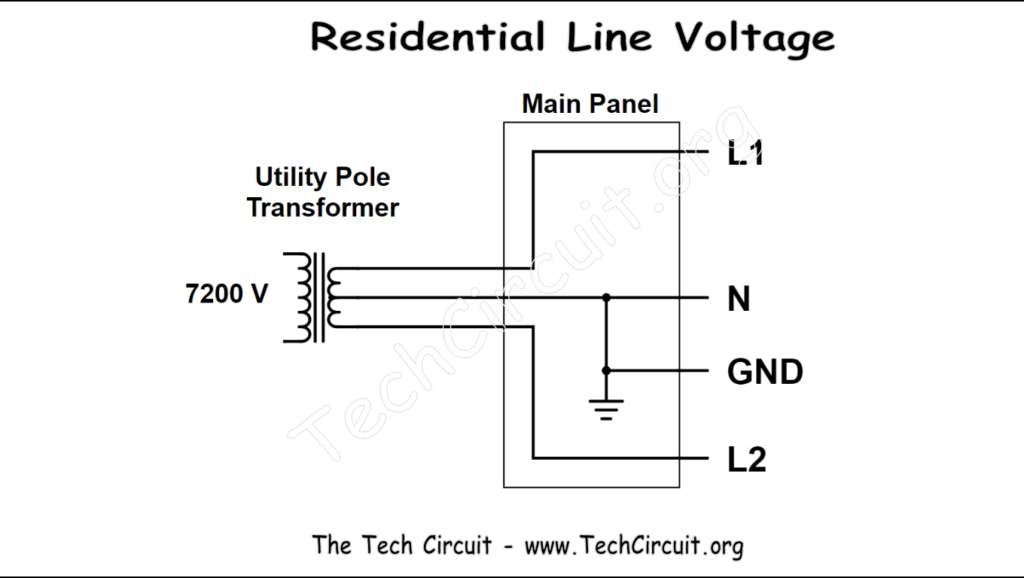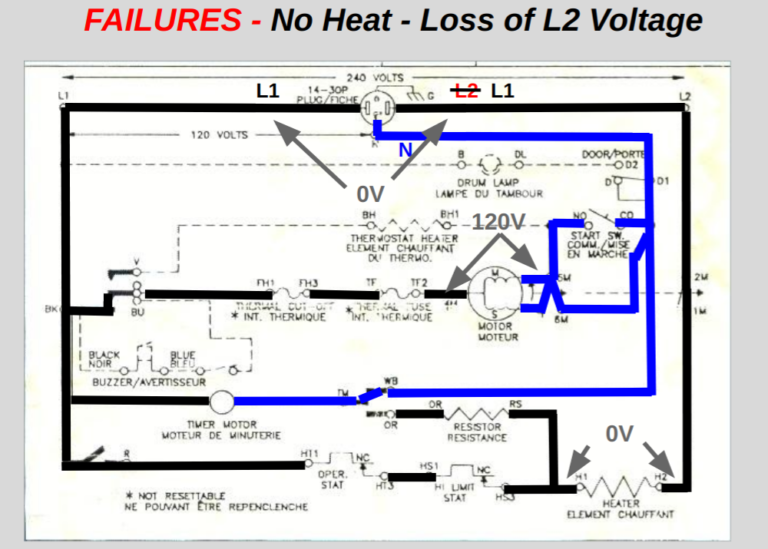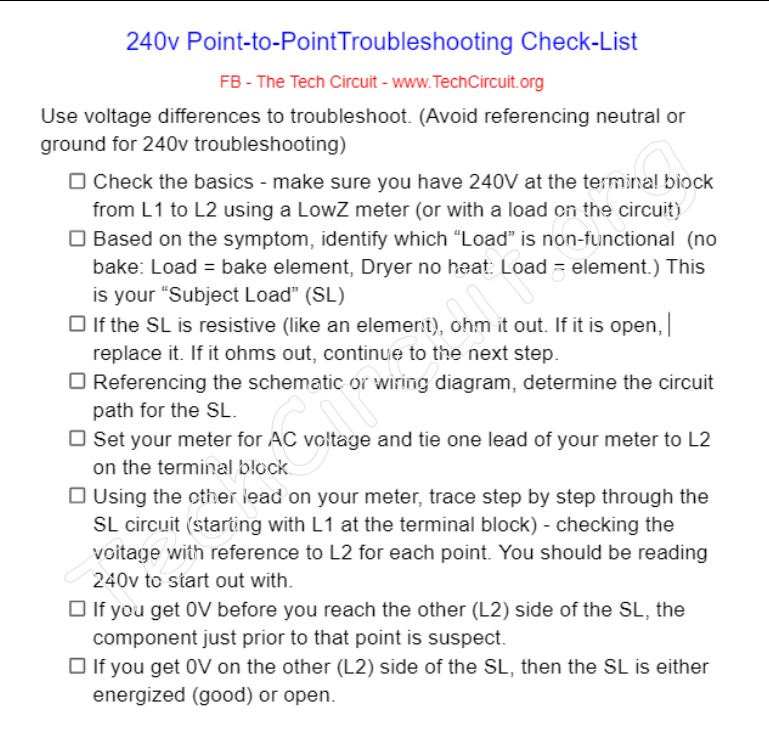
Should you Reference Neutral when Testing 240v Circuits?
How many times have you heard a technician state “I’m getting 120v on both sides of the element and it still doesn’t get hot”?
Technicians can get confused when working on an appliance that has lost L2, for example. If L1 feeds through a dryer element and shows up at the L2 terminal, they may think that L1 and L2 are making it to the element since they’re reading 120v with respect to Neutral on both sides. However, this is not true. In fact, they are reading the same 120v. To understand why, we must be versed in how single split-phase electrical service works.
As illustrated below, in a single split-phase system, L1 and L2 are the outputs of a step-down transformer (often found on a utility pole), which has a center-tap for Neutral. L1-N is 120v, and L2-N is likewise 120v. L1 and L2 are in-phase with each other and add up to a total of 240v. However, in the special case where Neutral is the reference point, L1 and L2 are measured as 180 degrees out of phase. So, when using a multimeter referenced to Neutral, both L1 and L2 will read 120v but be of opposite polarity to each other. What are the ramifications of this? It becomes significant when attempting to reference Neutral in your 240v circuit diagnostics. Why? Because Neutral isn’t part of, nor relevant to, 240v circuits derived from L1 to L2, such as those for elements in electric dryers and ranges.

This is illustrated in the failure case below for an electric dryer, where the leg on the right side of the terminal block should be L2. When the dryer is on and in heat mode, L1 travels through the thermal devices, the heating element, and the motor’s centrifugal switch, and shows up where L2 should be.
- Notice in the diagram that the difference between what should be L1 and L2 is 0 volts.
- The load has 0 volts across it.
- If you measure from Neutral to either L1 or L2, however, you get 120 volts – this is what can confuse technicians.
- If you measure from Neutral to either side of the element, you get 120 volts. You may think that the difference is 240 volts. It isn’t. Since the 120v on each side of the element are 180 degrees out of phase w/r to Neutral, the difference is 120v – 120v = 0v.

The above example is just one of many reasons why using Neutral as a reference when diagnosing 240v circuits can lead to trouble. In most 240v appliance circuits, the load is powered by the difference between L1 and L2. Neutral does not play a role. Therefore, using either L1 or L2 as a reference is the most effective approach to such diagnostics. Additionally, it’s important to note that ground is not part of a 240v circuit either and should not be used as a reference.
When Should you Reference Neutral?
If you suspect that L1 or L2 may not be reaching the outlet, or that Neutral may be floating, referencing Neutral can be useful, but only when the appliance is unplugged. This eliminates the possibility of back-feed through the appliance. To do this, use your voltmeter to test between Neutral and ground. You should get a reading of 0v since they are both bonded together in the breaker box. If you measure a voltage higher than 0v, it indicates a floating Neutral or a loose ground. If your Neutral is solid and not floating, you can then determine if L1 or L2 are also solid (low impedance). Test from Neutral to L1 using the LowZ function on your voltmeter. You should get a reading of 120v. Repeat the same test for L2 with respect to Neutral. Once you have established these readings, there’s no need to further reference Neutral in your 240v appliance diagnostics. This basic “line voltage” testing methodology is explained here: https://techcircuit.org/line-voltage-testing-cheat-sheet/ .
In certain situations, accessing the Neutral wire at the terminal block may not be convenient, particularly in the case of a built-in oven. However, you can still gain an indication of the presence of L1 or L2 by referencing Neutral (or even ground) from the control panel area. While this is not an ideal solution, this exception allows you to avoid the need to remove the oven in order to thoroughly verify a stable voltage source.
How to Diagnose a 240v Appliance Circuit
Here is a step-by-step diagnostic guide for effectively troubleshooting 240v circuits without referencing Neutral:

By following these steps, you can effectively troubleshoot and diagnose issues in 240v circuits without risking the diagnostic fallacy posed by referencing Neutral.
Summary
When troubleshooting a 240v circuit, it is crucial to exclude Neutral (and ground) from the diagnostic process. Referencing Neutral or ground in a 240v circuit generally leads to a “diagnostic fallacy” that can result in misleading readings. Acting upon these erroneous readings can lead to incorrect diagnoses and unnecessarily prolonged troubleshooting. By omitting Neutral (and ground) from your tests, you confine the diagnostics solely within the realm of the 240v circuit, which is the appropriate approach.
Don’t forget:
“Diverting 10 min/day of social media time towards learning something new, is 5 hours of newfound monthly knowledge.” – SM
Alphabetical Links to all Tech Circuit Articles and Blogs – CLICK HERE
Links to all Tech Circuit Cheat Sheets/Field References for Appliance/HVAC Techs – CLICK HERE
To DONATE to the Tech Circuit – CLICK HERE
For additional electrical and electronics learning material for field techs, visit our YouTube Channel
at https://www.youtube.com/c/TheTechCircuit or
our Facebook Group at https://www.facebook.com/groups/746823709133603
TC
